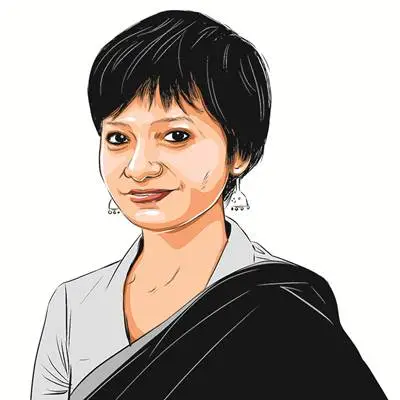Opinion The ‘tradwife’ offers only the illusion of a feminist choice
When a term that glamourises women’s subservience is normalised as just another lifestyle label, it puts the next generation of women at risk
 In our society, the stakes of women’s financial dependence are profound. In 2025, dowry harassment still claims lives.
In our society, the stakes of women’s financial dependence are profound. In 2025, dowry harassment still claims lives. Picture this: In a sun-drenched, immaculate kitchen, a woman wearing a lacy red gown is arranging a fresh fruit platter. In another kitchen, another woman in a designer dress, with perfect makeup, is baking bread, making cheese and sugar from scratch. These are just two examples from the thousands of videos that have gone viral in the last few years. The common theme: Women talking about protecting “femininity the way God created it to be” or how to “attract provider men”. They present submission to the husbands as women’s “natural” calling. The top comments from viewers usually are some version of “the dream”, “goals”, “true femininity”. This trend has now reached India with social media influencers promoting a similar mindset.
This is the tradwife trend, short for “traditional wife”. Projected as a woman who embraces traditional gender roles in pleasing aesthetics, centering her life around domestic labour, childcare, and subservience to her husband, the use of the term tradwife has been widespread since 2020, recently being recognised by the Cambridge Dictionary.
Supporters of this trend present it as an expression of women’s autonomy. It is often defended under the umbrella of “choice feminism”, which suggests that any decision a woman makes is feminist if it stems from her own agency, a well informed-choice.
The argument does seem compelling. Why can’t women find fulfillment in domesticity? Is feminism not about respecting one’s choices? The answer depends on context and prevailing systems. When patriarchy is the dominant culture, is a woman’s choice of conformity truly her own?
Choice feminism equates any personal choice as empowerment. But individual decisions are rarely made in isolation from social structures and systemic hurdles. Cultural expectations, economic status, and social conditioning strongly shape opinions and decisions. It is also about class and caste privilege. Women, when they choose against tradition and culture, especially in rural India, often face stigma or even physical violence. The claim that conformity is simply a personal choice is rarely the whole picture.
At the core, feminism is about challenging the systems of oppression to achieve equity. The choice to pursue a career or to embrace domestic subservience are not equal in our country. Any choice that upholds patriarchal practices is not feminism.
Ironically, the tradwife aesthetic, presented as a result of women’s agency, creates a seductive image of domestic bliss. On impressionable young girls who are scrolling their feed, this imagery can leave a lasting impact. They may associate the picture-perfect fantasy as glamorous, thereby making submission aspirational. These trends could encourage young girls to see financial dependency on husbands as an easy option, free from the grind of an independent career.
This narrowing of horizons is made worse by institutions sowing seeds of regression in their curriculum. Instead of adding more women leaders who stood for courage and leadership to serve as role models, for example, the NCERT has recently deleted Razia Sultan and Noor Jahan from its textbooks. This omission carries the underlying suggestion that a certain community offers little space for women’s growth. When strong women from diverse backgrounds are erased from classrooms, the vacuum is filled by easily available online stereotypes. Without such role models, girls are denied the knowledge that women before them, irrespective of communities, have been leaders and heralded reforms in societies. And they can, too.
In our society, the stakes of women’s financial dependence are profound. In 2025, dowry harassment still claims lives. Just in the last few months, we have seen a string of dowry-related deaths hit the national headlines. According to the National Crime Records Bureau’s data of 2022, 6,416 women have died due to dowry harassment in that year alone. Beyond these cases, countless women, both in rural and urban settings, experience domestic violence, marital rape, and mental harassment.
It goes without saying that women without an independent income or property are less able to leave abusive marriages. They remain in these households out of necessity. Most families do not want their married daughter to return, despite harassment by their husbands or in-laws. In such a situation, embracing the tradwife ideal is not a neutral lifestyle choice but a dangerous gamble.
most read
Of course, there is nothing wrong with homemaking or caring for one’s family, in fact everyone, including men, should do it. The concern arises when these roles are packaged as the superior calling for women in contrast to other jobs. For millions of Indian women, freedom will not come from reviving old ideals of domesticity but from building a society where women have safety, equity, and independence. Until then, there is no true agency. The tradwife illusion ignores these realities.
Let us not forget that submission is not empowerment. When a term that glamourises women’s subservience is normalised as just another lifestyle label, it puts the next generation of women at risk. Once again, feminists must fight back.
The writer is the founder of Femme First Foundation and the lead author of The Fifteen: The Lives and Times of the Women in India’s Constituent Assembly






